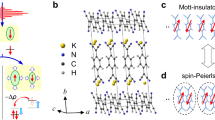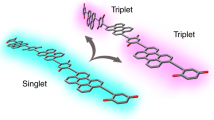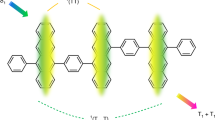Abstract
Understanding the photophysics and photochemistry of molecular π-stacked chromophores is important for utilizing them as functional photonic materials. However, these investigations have been mostly limited to covalent molecular dimers, which can only approximate the electronic and vibronic interactions present in the higher oligomers typical of functional organic materials. Here we show that a comparison of the excited-state dynamics of a covalent slip-stacked perylenediimide dimer (2) and trimer (3) provides fundamental insights into electronic state mixing and symmetry-breaking charge separation (SB-CS) beyond the dimer limit. We find that coherent vibronic coupling to high-frequency modes facilitates ultrafast state mixing between the Frenkel exciton (FE) and charge-transfer (CT) states. Subsequently, solvent fluctuations and interchromophore low-frequency vibrations promote CT character in the coherent FE/CT mixed state. The coherent FE/CT mixed state persists in 2, but, in 3, low-frequency vibronic coupling collapses the coherence, resulting in ultrafast SB-CS between the distal perylenediimide units.

This is a preview of subscription content, access via your institution
Access options
Access Nature and 54 other Nature Portfolio journals
Get Nature+, our best-value online-access subscription
$29.99 / 30 days
cancel any time
Subscribe to this journal
Receive 12 print issues and online access
$259.00 per year
only $21.58 per issue
Buy this article
- Purchase on Springer Link
- Instant access to full article PDF
Prices may be subject to local taxes which are calculated during checkout






Similar content being viewed by others
Data availability
Spectroscopic data and analysis, as well as the synthesis and characterization of 2 and 3, are available in the Supplementary Information. Source data are provided with this paper.
Code availability
Codes for analysing the broadband TA data are available from M.R.W. upon request.
References
Vauthey, E. Photoinduced symmetry-breaking charge separation. ChemPhysChem 13, 2001–2011 (2012).
Dereka, B., Koch, M. & Vauthey, E. Looking at photoinduced charge transfer processes in the IR: answers to several long-standing questions. Acc. Chem. Res. 50, 426–434 (2017).
Dereka, B. & Vauthey, E. Solute-solvent interactions and excited-state symmetry breaking: beyond the dipole-dipole and the hydrogen-bond interactions. J. Phys. Chem. Lett. 8, 3927–3932 (2017).
Vos, M. H., Rappaport, F., Lambry, J.-C., Breton, J. & Martin, J.-L. Visualization of coherent nuclear motion in a membrane protein by femtosecond spectroscopy. Nature 363, 320–325 (1993).
Romero, E., Novoderezhkin, V. I. & van Grondelle, R. Quantum design of photosynthesis for bio-inspired solar-energy conversion. Nature 543, 355–365 (2017).
Bartynski, A. N. et al. Symmetry-breaking charge transfer in a zinc chlorodipyrrin acceptor for high open circuit voltage organic photovoltaics. J. Am. Chem. Soc. 137, 5397–5405 (2015).
Sisson, A. L. et al. Zipper assembly of vectorial rigid-rod π-stack architectures with red and blue naphthalenediimides: toward supramolecular cascade n/p-heterojunctions. Angew. Chem. Int. Ed. 47, 3727–3729 (2008).
Aratani, N., Kim, D. & Osuka, A. Discrete cyclic porphyrin arrays as artificial light-harvesting antenna. Acc. Chem. Res. 42, 1922–1934 (2009).
Margulies, E. A. et al. Enabling singlet fission by controlling intramolecular charge transfer in π-stacked covalent terrylenediimide dimers. Nat. Chem. 8, 1120–1125 (2016).
Kaufmann, C. et al. Ultrafast exciton delocalization, localization and excimer formation dynamics in a highly defined perylene bisimide quadruple π-stack. J. Am. Chem. Soc. 140, 4253–4258 (2018).
Kim, T. et al. Switching resonance character within merocyanine stacks and its impact on excited-state dynamics. Chem 7, 715–725 (2021).
Wűrthner, F. et al. Perylene bisimide dye assemblies as archetype functional supramolecular materials. Chem. Rev. 116, 962–1052 (2016).
Kasha, M., Rawls, H. & El-Bayoumi, M. A. The exciton model in molecular spectroscopy. Pure Appl. Chem. 11, 371–392 (1965).
Davydov, A. The theory of molecular excitons. Phys. Usp. 7, 145–178 (1964).
Hestand, N. J. & Spano, F. C. Molecular aggregate photophysics beyond the Kasha model: novel design principles for organic materials. Acc. Chem. Res. 50, 341–350 (2017).
Spano, F. C. The spectral signatures of Frenkel polarons in H- and J-aggregates. Acc. Chem. Res. 43, 429–439 (2010).
Oleson, A. et al. Perylene diimide-based Hj- and hJ-aggregates: the prospect of exciton band shape engineering in organic materials. J. Phys. Chem. C 123, 20567–20578 (2019).
Zubiria-Ulacia, M., Matxain, J. M. & Casanova, D. The role of CT excitations in PDI aggregates. Phys. Chem. Chem. Phys. 22, 15908–15918 (2020).
Canola, S. et al. Addressing the Frenkel and charge transfer character of exciton states with a model Hamiltonian based on dimer calculations: application to large aggregates of perylene bisimide. J. Chem. Phys. 154, 124101 (2021).
Bialas, D., Kirchner, E., Röhr, M. I. S. & Würthner, F. Perspectives in dye chemistry: a rational approach toward functional materials by understanding the aggregate state. J. Am. Chem. Soc. 143, 4500–4518 (2021).
Lim, J. M. et al. Exciton delocalization and dynamics in helical π-stacks of self-assembled perylene bisimides. Chem. Sci. 4, 388–397 (2013).
Son, M., Park, K. H., Shao, C., Wurthner, F. & Kim, D. Spectroscopic demonstration of exciton dynamics and excimer formation in a sterically controlled perylene bisimide dimer aggregate. J. Phys. Chem. Lett. 5, 3601–3607 (2014).
Margulies, E. A., Shoer, L. E., Eaton, S. W. & Wasielewski, M. R. Excimer formation in cofacial and slip-stacked perylene-3,4:9,10-bis (dicarboximide) dimers on a redox-inactive triptycene scaffold. Phys. Chem. Chem. Phys. 16, 23735–23742 (2014).
Sung, J., Kim, P., Fimmel, B., Wűrthner, F. & Kim, D. Direct observation of ultrafast coherent exciton dynamics in helical π-stacks of self-assembled perylene bisimides. Nat. Commun. 6, 8646 (2015).
Mauck, C. M., Young, R. M. & Wasielewski, M. R. Characterization of excimer relaxation via femtosecond shortwave- and mid-infrared spectroscopy. J. Phys. Chem. A 121, 784–792 (2017).
Kim, W. et al. Solvent-modulated charge-transfer resonance enhancement in the excimer state of a bay-substituted perylene bisimide cyclophane. J. Phys. Chem. Lett. 10, 1919–1927 (2019).
Myong, M. S., Zhou, J., Young, R. M. & Wasielewski, M. R. Charge-transfer character in excimers of perylenediimides self-assembled on anodic aluminum oxide membrane walls. J. Phys. Chem. C 124, 4369–4377 (2020).
Kang, S., Kim, T., Hong, Y., Wűrthner, F. & Kim, D. Charge-delocalized state and coherent vibrational dynamics in rigid PBI H-aggregates. J. Am. Chem. Soc. 143, 9825–9833 (2021).
Giaimo, J. M., Gusev, A. V. & Wasielewski, M. R. Excited-state symmetry breaking in cofacial and linear dimers of a green perylenediimide chlorophyll analogue leading to ultrafast charge separation. J. Am. Chem. Soc. 124, 8530–8531 (2002).
Sung, J. et al. Direct observation of excimer-mediated intramolecular electron transfer in a cofacially-stacked perylene bisimide pair. J. Am. Chem. Soc. 138, 9029–9032 (2016).
Ramirez, C. E. et al. Symmetry-breaking charge separation in the solid state: tetra(phenoxy)perylenediimide polycrystalline films. J. Am. Chem. Soc. 142, 18243–18250 (2020).
Coleman, A. F. et al. Reversible symmetry-breaking charge separation in a series of perylenediimide cyclophanes. J. Phys. Chem. C 124, 10408–10419 (2020).
Farag, M. H. & Krylov, A. I. Singlet fission in perylenediimide dimers. J. Phys. Chem. C 122, 25753–25763 (2018).
Le, A. K. et al. Singlet fission involves an interplay between energetic driving force and electronic coupling in perylenediimide films. J. Am. Chem. Soc. 140, 814–826 (2018).
Carlotti, B. et al. Activating intramolecular singlet exciton fission by altering π-bridge flexibility in perylene diimide trimers for organic solar cells. Chem. Sci. 11, 8757–8770 (2020).
Hong, Y. et al. Efficient multiexciton state generation in charge-transfer-coupled perylene bisimide dimers via structural control. J. Am. Chem. Soc. 142, 7845–7857 (2020).
Hoche, J. et al. The mechanism of excimer formation: an experimental and theoretical study on the pyrene dimer. Phys. Chem. Chem. Phys. 19, 25002–25015 (2017).
Hoche, J. et al. Excimer formation dynamics in the isolated tetracene dimer. Chem. Sci. 12, 11965–11975 (2021).
Mandal, A. et al. Two-dimensional electronic spectroscopy reveals excitation energy-dependent state mixing during singlet fission in a terrylenediimide dimer. J. Am. Chem. Soc. 140, 17907–17914 (2018).
Young, R. M. & Wasielewski, M. R. Mixed electronic states in molecular dimers: connecting singlet fission, excimer formation and symmetry-breaking charge transfer. Acc. Chem. Res. 53, 1957–1968 (2020).
Kistler, K., Pochas, C., Yamagata, H., Matsika, S. & Spano, F. Absorption, circular dichroism and photoluminescence in perylene diimide bichromophores: polarization-dependent H- and J-aggregate behavior. J. Phys. Chem. B 116, 77–86 (2012).
Kaufmann, C., Bialas, D., Stolte, M. & Wűrthner, F. Discrete π-stacks of perylene bisimide dyes within folda-dimers: insight into long- and short-range exciton coupling. J. Am. Chem. Soc. 140, 9986–9995 (2018).
Sebastian, E. & Hariharan, M. Null exciton-coupled chromophoric dimer exhibits symmetry-breaking charge separation. J. Am. Chem. Soc. 143, 13769–13781 (2021).
Wu, Y. et al. Ultrafast photoinduced symmetry-breaking charge separation and electron sharing in perylenediimide molecular triangles. J. Am. Chem. Soc. 137, 13236–13239 (2015).
Fuller, F. D. et al. Vibronic coherence in oxygenic photosynthesis. Nat. Chem. 6, 706–711 (2014).
De Sio, A. et al. Tracking the coherent generation of polaron pairs in conjugated polymers. Nat. Commun. 7, 13742 (2016).
Bakulin, A. A. et al. Real-time observation of multiexcitonic states in ultrafast singlet fission using coherent 2D electronic spectroscopy. Nat. Chem. 8, 16–23 (2016).
De Sio, A. & Lienau, C. Vibronic coupling in organic semiconductors for photovoltaics. Phys. Chem. Chem. Phys. 19, 18813–18830 (2017).
Stern, H. L. et al. Vibronically coherent ultrafast triplet-pair formation and subsequent thermally activated dissociation control efficient endothermic singlet fission. Nat. Chem. 9, 1205–1212 (2017).
Miyata, K. et al. Coherent singlet fission activated by symmetry breaking. Nat. Chem. 9, 983–989 (2017).
Gaynor, J. D., Sandwisch, J. & Khalil, M. Vibronic coherence evolution in multidimensional ultrafast photochemical processes. Nat. Commun. 10, 5621 (2019).
Arsenault, E. A., Bhattacharyya, P., Yoneda, Y. & Fleming, G. R. Two-dimensional electronic-vibrational spectroscopy: exploring the interplay of electrons and nuclei in excited state molecular dynamics. J. Chem. Phys. 155, 020901 (2021).
Schultz, J. D. et al. Influence of vibronic coupling on ultrafast singlet fission in a linear terrylenediimide dimer. J. Am. Chem. Soc. 143, 2049–2058 (2021).
Halpin, A. et al. Two-dimensional spectroscopy of a molecular dimer unveils the effects of vibronic coupling on exciton coherences. Nat. Chem. 6, 196–201 (2014).
Lim, J. et al. Vibronic origin of long-lived coherence in an artificial molecular light harvester. Nat. Commun. 6, 7755 (2015).
Christensson, N., Kauffmann, H. F., Pullerits, T. & Mančal, T. Origin of long-lived coherences in light-harvesting complexes. J. Phys. Chem. B 116, 7449–7454 (2012).
Kim, W. et al. Tracking structural evolution during symmetry-breaking charge separation in quadrupolar perylene bisimide with time-resolved impulsive stimulated Raman spectroscopy. Angew. Chem. Int. Ed. 59, 8571–8578 (2020).
Rafiq, S., Fu, B., Kudisch, B. & Scholes, G. D. Interplay of vibrational wavepackets during an ultrafast electron transfer reaction. Nat. Chem. 13, 70–76 (2021).
Kim, P. et al. Ultrafast excited-state dynamics of photoluminescent Pt(II) dimers probed by a coherent vibrational wavepacket. J. Phys. Chem. Lett. 12, 6794–6803 (2021).
Rafiq, S. & Scholes, G. D. From fundamental theories to quantum coherences in electron transfer. J. Am. Chem. Soc. 141, 708–722 (2019).
Young, R. M. et al. Ultrafast conformational dynamics of electron transfer in ExBox4+⊂perylene. J. Phys. Chem. A 117, 12438–12448 (2013).
Shao, Y. et al. Advances in molecular quantum chemistry contained in the Q-Chem 4 program package. Mol. Phys. 113, 184–215 (2015).
Acknowledgements
This work was supported by the US Department of Energy, Office of Science, Office of Basic Energy Sciences, under award no. DE-FG02-99ER14999 (to M.R.W.). This material is based on work supported by the National Science Foundation Graduate Research Fellowship Program under grant no. DGE-1842165 (to J.D.S.). This work made use of the IMSERC MS and NMR facility at Northwestern University, which has received support from the Soft and Hybrid Nanotechnology Experimental (SHyNE) Resource (NSF ECCS-2025633), the State of Illinois, the International Institute for Nanotechnology (IIN) and Northwestern University.
Author information
Authors and Affiliations
Contributions
C.L. synthesized and characterized the molecules, acquired the narrowband TA data, analysed the data and prepared the manuscript. T.K. acquired the broadband TA and fsIR data, analysed the data, performed the computational studies and prepared the manuscript. J.D.S. analysed the broadband TA data. M.R.W. and R.M.Y. designed the experiments, directed the investigations and prepared the manuscript with contributions from all the authors. All authors contributed to discussions.
Corresponding authors
Ethics declarations
Competing interests
The authors declare no competing interests.
Peer review
Peer review information
Nature Chemistry thanks Mahesh Hariharan, Dongho Kim and the other, anonymous, reviewer(s) for their contribution to the peer review of this work.
Additional information
Publisher’s note Springer Nature remains neutral with regard to jurisdictional claims in published maps and institutional affiliations.
Supplementary information
Supplementary Information
Supplementary Figs. 1–55, Discussion and Tables 1–6.
Source data
Source Data Fig. 2
Steady-state absorption and fluorescence of 1, 2, and 3 in THF.
Source Data Fig. 3
Narrowband and broadband transient absorption results.
Source Data Fig. 4
Femtosecond infrared data in deuterated dichloromethane.
Source Data Fig. 5
Wavepacket data including FT power, residuals, short-time FT, and FFT filter results.
Rights and permissions
About this article
Cite this article
Lin, C., Kim, T., Schultz, J.D. et al. Accelerating symmetry-breaking charge separation in a perylenediimide trimer through a vibronically coherent dimer intermediate. Nat. Chem. 14, 786–793 (2022). https://doi.org/10.1038/s41557-022-00927-y
Received:
Accepted:
Published:
Issue Date:
DOI: https://doi.org/10.1038/s41557-022-00927-y
This article is cited by
-
Anomalous deep-red luminescence of perylene black analogues with strong π-π interactions
Nature Communications (2023)
-
Carrier Dynamics and Surface Reaction Boosted by Polymer-based Single-atom Photocatalysts
Chemical Research in Chinese Universities (2022)



